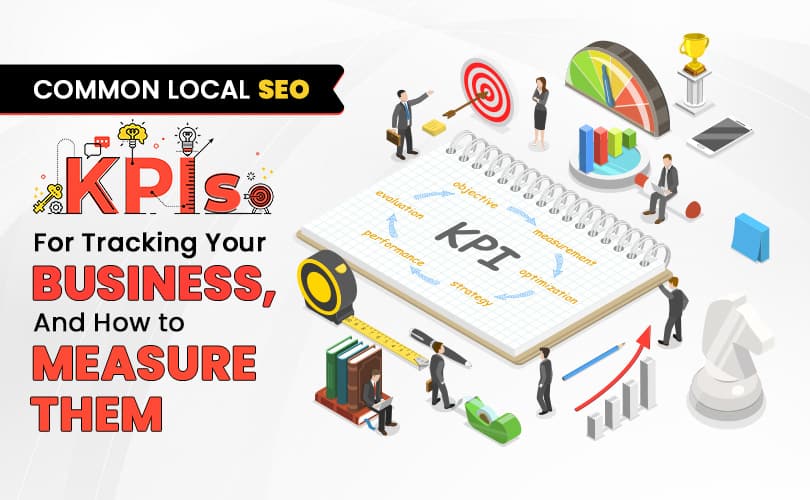Common Local SEO KPIs for Tracking Your Business, and How to Measure Them

Going through regular reports on your business SEO stats is one of the best ways to keep pace with the ever-changing landscape of search engine optimization. But since there are so many possible metrics to consider, it can be hard to know where to focus your attention.
Traffic, local search, clicks, and impressions are all crucial SEO factors, but each of these can impact your overall results differently. By keeping a good forest’s-eye on all of them, you can gain a better understanding about which areas may need improvement and adjust your strategy accordingly.
Here are some tips for tracking the most critical SEO metrics
1. Google My Business Insights
There are many metrics in Google My Business that you can monitor, but here are two of the most important.
Page Views: This metric tells you how many times people viewed your business page, and this is a good indicator about what kind of traffic your business is drawing.
Engagement: This metric relays how often people interact with your page. These metrics include calls to your business, clicks on your website, and direction requests. This is a good indicator of how warmer leads are actually engaging your business.
2. Customer Actions
This metric shows the number of actions people take after viewing your page. It includes form submissions, chats, direction requests, downloads, and phone calls. This helps to indicate how effective your page is at converting interested viewers into customers.
Google My Business metrics like these can give you a good idea of how your business is performing and where there’s room for improvement. Monitor these trends so that you know what’s working for you and what isn’t. It’s also a good idea to compare your performance with that of your competitors to see where you may be ahead and where you’re lagging behind. Understanding what these metrics are telling you can help you to market your business online more effectively.
3. Local Listings
Obviously, you want your business to be visible in local search results. To that end, you need to make sure your listings are accurate and up-to-date. There are some tools available that allow you to manage your listings in a quick-and-easy manner.
Yext, MozLocal, HooverAll, and Uberall are all great options for helping to keep your listings accurate and free of duplicates. Duplicate listings can end up hurting your SEO performance, so it’s best to eliminate them.
By paying attention to the accuracy and currency of your listings, you’ll improve your chances of showing up in local search results, which ultimately means more customers for your business.
4. Customer Reviews
Some great places to check review metrics include Google My Business, Yelp, and Bing Local Listings. Keep in mind that generating reviews is just one part of the puzzle – it’s also essential to understand the quantity and quality of those reviews.
Overall, paying attention to reviews can give you a better understanding of your local SEO progress. By monitoring your review metrics, you can make more informed decisions – not just about your marketing strategy, but about tweaks you can make with your business to make it work even better for your customers.
5. Traffic
This is perhaps the most obvious metric to track, but it’s also one of the most important. After all, if you’re not getting any traffic on your website, then it’s really not making much of a difference for your business.
There are several ways to track traffic, but it’s always important to make sure you’re looking at organic traffic – that is, the visitors who find your site through search engines.
You can use Google Analytics to track your organic traffic, or you can also install a plugin like Yoast SEO which can deliver detailed traffic reports right to your WordPress dashboard.
6. Local Search
Local search should definitely be a top priority if you have a brick-and-mortar business. After all, having a great website otherwise doesn’t much matter if no one in your area can find it!
There are a few different ways to track your local search ranking, but one of the easiest is simply to conduct a search for your business name and see where you show up. You can also use Moz Local to track your listing in multiple directories.
7. Clicks
Another critical metric to track is the number of clicks from organic search results. This can give you an idea of how well your website is optimized and whether or not people are finding what they’re looking for whenever they visit your site.
Again, Google Analytics can be used to track this metric, or you can install a plugin like WP Click Tracker, which can supply detailed reports about all the clicks on your website.
8. Impressions
What are impressions? They’re the number of times your website appears in organic search results, regardless of whether it gets clicked on or not.
This metric can sometimes be tricky to track, but Google Analytics offers some basic reporting on impressions. You can also use a plugin like Yoast SEO to give you more detailed impression data for every one of your pages and posts.
9. Average Page Load Time
The average page load time is the typical amount of time it takes for a page to load fully. This includes all content, images, and other elements on the page.
A slow page load time can have several negative consequences. First, it can lead to higher bounce rates, as users are likely to click away from a page that takes too long to load. Second, Google has stated that slow loading times can hurt your website’s search engine rankings, as well.
There are several ways to measure your average page load time. One way is to use Google’s PageSpeed Insights tool. This tool will give you a score from 0-100 based on how fast your page loads. The higher the score, the quicker your page is.
Another way to measure your page load time is with Pingdom’s Website Speed Test. This tool will show you how long it takes for your page to load, along with more details about the specific types of resources which are loading on each page.
10. Click-Through Rates
Click-Through Rates (or CTR) measure how users are clicking on your ads or organic SEO results. This is a pretty good indicator of how well your campaign is performing and whether or not users are engaged with your content.
To find out your CTR, divide the number of clicks by the number of impressions (times your ad was shown). For example, if your ad received 100 clicks and had 1,000 impressions, your CTR would be 10%.
You especially want to know the click-through rate for individual keywords (and pages), so you can optimize which terms you are targeting over time. A page view may translate directly to an in-person sale for local SEO, so this metric is crucial.
Take a look at your web analytics to see how much traffic your site is getting from organic search. Then, look at your CTR for different campaigns and keywords to better understand which ones are performing well and which could use some improvement. With this information in hand, you can make the necessary changes to improve your overall CTR and digital marketing ROI.
11. Local Search Ranking
Concerned about your local search ranking? Well, you should be! Local search is becoming increasingly important, especially for businesses that rely primarily on foot traffic.
Thankfully, there are some strategies you can follow to help improve your ranking. One is to make sure your Google My Business page is up-to-date and optimized. You’ll also want to track where you’re ranking for specific keywords, and you absolutely want to make sure your business is showing up in local Google Maps results.
In addition, many local searches offer additional features and functionality. For example, you can include a link to book a reservation at your restaurant right on the local search results page! It’s essential to audit all of the search functions that are available to you and to enable those which apply to your particular business.
12. Traffic Pattern Metrics
You should be aware of a few key traffic pattern metrics when it comes to an understanding how your website is trending. Here are two patterns worth following:
♦ Keyword growth or decline
This metric helps you understand how individual keywords perform over time. Are specific keywords growing or declining in popularity? Being armed with this information can help you to adjust your content strategy accordingly.
♦ Overall traffic growth or decline
This metric gives you a big-picture view of how your website is performing. Is your traffic increasing or decreasing? If you’re starting to see a decrease, you should be prompt about investigating why.
By understanding key traffic patterns like these, you can make more informed decisions about how to maximize the performance of your website.
Keep an Eye on Your SEO Metrics
SEO is a constantly evolving landscape, so it’s important to keep a wary eye on your metrics so you can adjust your strategy accordingly. Got more questions about how to optimize your business website for better performance? Ready to tap into the power of other relevant strategies like PPC ads, social media, and email marketing?
Cibirix provides all things digital marketing for a range of business clients, and we’re here to help your business Rise Digitally, too. Connect with one of our experts today!
About Author
Amrita Khandelwal
Amrita is one of the professional SEO analyst for the Cibirix marketing team. She applies her in-depth knowledge and experience to help boost website rankings for both our B2B and B2C business clients, ultimately producing more traffic for their sites. She is intentional about creating an individualized link-building strategy that’s not just creative, but ethical as well – she’s always careful not to violate any of Google’s SEO policies. Amrita believes in building links which will elevate our clients’ respective brands both effectively and sustainably. During her spare time between SEO projects, Amrita loves to read books and follow blogs related to nutrition and yoga.




